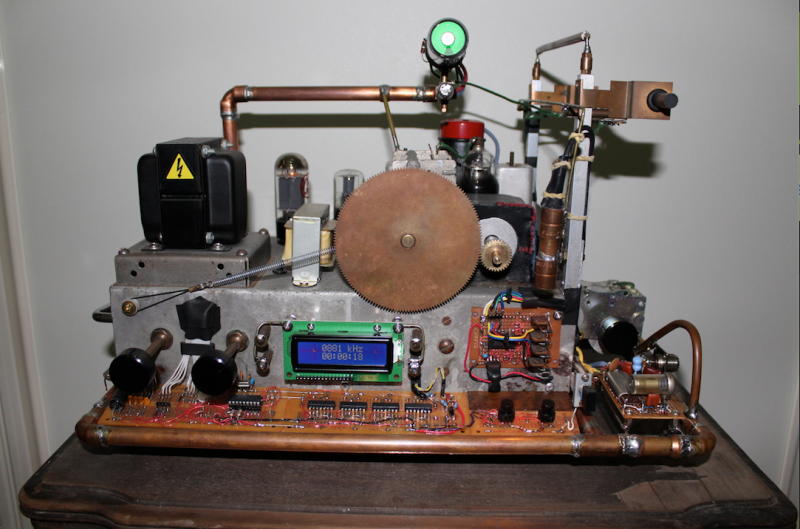Dubbed the “Robot Radio” by [Brek], this clinking-&-clunking project merges three generations of hackers’ favorite technologies: robots, vacuum tubes, and microcontrollers. After the human inputs the desired radio frequency the machine chisels its way through the spectrum, trying its best to stay on target.
This build began its life as a junky old tube radio that [Brek] pulled out of a shed. The case was restored and then the hacking began. Inserted between the human and the radio, a PIC 16F628A keeps watch in both directions. On one side, the radio’s tank circuit is monitored to see what frequency the radio is currently playing. On the other, the human’s input sets a desired frequency. If the two do not match, the PIC tells a stepper motor to begin cranking a pair of gears until they do.
Another interesting feature is that as the tubes and other electronics warm up and change their values, the matching circuit will keep them in line. [Brek] shows this in the video by deliberately sabotaging the gears and seeing the robot adjust them back where they belong.
As an afterthought, the Robot Radio was supplemented with a module that adds 100khz to the signal so that the information from a nearby airport can be received.
[Brek] styled the whole machine up with some copper framing and other bits, similar to his spectacular atomic clock build we featured last month.
See the video of the radio tuning after the break.
(Note: Yes, the first few seconds lack audio, it’s not just you. Wait for it.)
(Note 2: Yes, all the progress vids in the thread except the last were deleted, it’s not just you.)
















The drift compensation is nice, but the Very Loud Clicking as it tunes seems like it might be as annoying as the radio being out of tune…
Being deep into Stars End on WXPN right now, I don’t want to hear the vid. Drift wasn’t a problem in any AM radio that I used. Decent radios I tuned in the day were good enough to let you tune and count the “channels” of noise or signal thus you knew the exact frequency that was what you were tuned to, if DXing.
Interesting work anyway. Brings to mind Vannever Bush’s WW2 dream of a numerically tuned radio. No relation to that other Bush selling coal to fuel the furnaces of the Third Reich.
Hi, I does correct itself by 1kHz interval at least once every warm up, not that it was really needed to hear the station. It’s satisfied so long at it’s flickering between the target freq and it’s closest integer, and only tries to correct if the target freq is not counted ten gate periods in a row… but the point is I learned how a superhet works from this very radio :) and proved it by mixing a tuned radio freq with 100 kHz to arrive at intelligence on the sum freq and delivering that IF to the radio’s IF directly. Now I’m confident to make an AM superhet from scratch, a BFO would be next on the menu.
CCR – worth the wait just for that.
So that’s what Rube Goldberg’s! Love the magic eye.
If it matters, I learned to drive in my parents’ 1962 Buick Electra 225 – old by then since it was the mid-70s, but still a lot of fun because of the monster engine etc. It had a “Wonderbar” tube radio (yes) in the dash that would do exactly this. When you hit the “scan” bar, it would mechanically sweep for the next station, minus all the stepping noise and stop at the next one that had a sufficiently loud signal.
http://www.kingoftheroad.net/59olds/album/source/59olds221.html
The truly fun part was that there was also a foot switch on the left side (I think) that would start the scan as well – big stuff in the days before steering wheel controls.
Here’s a page on it – note the Civil Defense markings on the dial:
http://57rustbucket.com/ac08.jpg
Nice hack. Certainly better than drawing frequency markers with a pen, like I did on my homebuilt radio :)
This is awesome. Simply awesome.
I think I might try to quiet the stepper down a bit, though. Maybe doing a rubber isolation mount of some sort for the stepper motor, and perhaps switching to a belt drive.